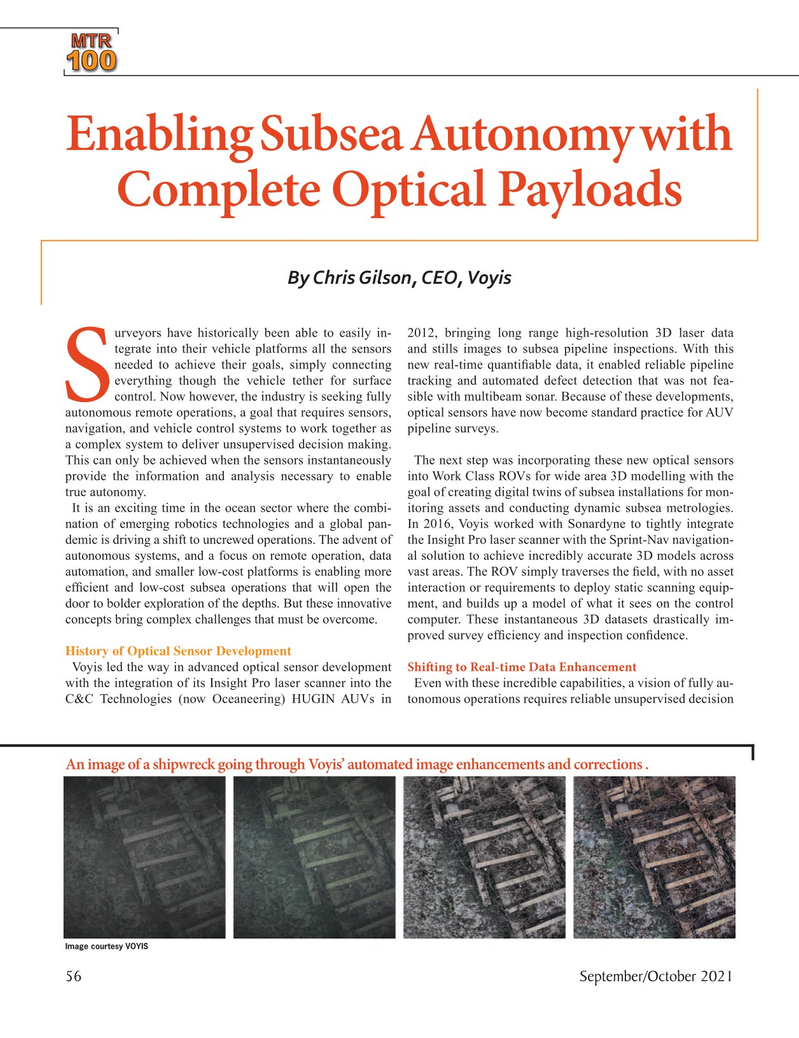
Page 56: of Marine Technology Magazine (September 2021)
MTR100: Focus on 100 Leading Companies, People and Innovations in the Subsea Space
Read this page in Pdf, Flash or Html5 edition of September 2021 Marine Technology Magazine
MTTTTTTTTTTTTTRM M M M M M M M M M M M M M M M M M M M M M M M M M M M MTRRRRRRRRRRRRRRRRRRRRRRRRRRRMTTTTTTTTTTTTTRMTR 100000000000000001111111111111111111111111111100000000000000000000000000000010000000000000000100
Enabling Subsea Autonomy with
Complete Optical Payloads
By Chris Gilson, CEO, Voyis urveyors have historically been able to easily in- 2012, bringing long range high-resolution 3D laser data tegrate into their vehicle platforms all the sensors and stills images to subsea pipeline inspections. With this needed to achieve their goals, simply connecting new real-time quanti? able data, it enabled reliable pipeline everything though the vehicle tether for surface tracking and automated defect detection that was not fea-
S control. Now however, the industry is seeking fully sible with multibeam sonar. Because of these developments, autonomous remote operations, a goal that requires sensors, optical sensors have now become standard practice for AUV navigation, and vehicle control systems to work together as pipeline surveys.
a complex system to deliver unsupervised decision making.
This can only be achieved when the sensors instantaneously The next step was incorporating these new optical sensors provide the information and analysis necessary to enable into Work Class ROVs for wide area 3D modelling with the true autonomy. goal of creating digital twins of subsea installations for mon-
It is an exciting time in the ocean sector where the combi- itoring assets and conducting dynamic subsea metrologies. nation of emerging robotics technologies and a global pan- In 2016, Voyis worked with Sonardyne to tightly integrate demic is driving a shift to uncrewed operations. The advent of the Insight Pro laser scanner with the Sprint-Nav navigation- autonomous systems, and a focus on remote operation, data al solution to achieve incredibly accurate 3D models across automation, and smaller low-cost platforms is enabling more vast areas. The ROV simply traverses the ? eld, with no asset ef? cient and low-cost subsea operations that will open the interaction or requirements to deploy static scanning equip- door to bolder exploration of the depths. But these innovative ment, and builds up a model of what it sees on the control concepts bring complex challenges that must be overcome. computer. These instantaneous 3D datasets drastically im- proved survey ef? ciency and inspection con? dence.
History of Optical Sensor Development
Voyis led the way in advanced optical sensor development Shif ing to Real-time Data Enhancement with the integration of its Insight Pro laser scanner into the Even with these incredible capabilities, a vision of fully au-
C&C Technologies (now Oceaneering) HUGIN AUVs in tonomous operations requires reliable unsupervised decision
An image of a shipwreck going through Voyis’ automated image enhancements and corrections .
Image courtesy VOYIS 56 September/October 2021
MTR #7 (50-65).indd 56 9/21/2021 11:32:06 AM

 55
55

 57
57
